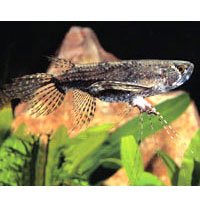superpeytonm
Aquarium Advice Freak
African Butterfly Fish (Pantodon buchholzi)
This fish may sound like a saltwater fish, but it is actually freshwater. They are commonly found in many lakes in Africa. The majority of its time is spent at the top of the water waiting for prey. The body of this fish is dark brown to black with lighter colorations. Its fins resemble a bird's wings, giving the African Butterflyfish a unique look. Although it stays rather small, you should be cautious as it will swallow anything it can fit into its mouth. If you would like to keep this fish as a pet, here's how. The ideal set-up would be a tank of at least 30 gallons, with plenty of plants that reach the surface for cover. They can survive in temperatures of a wide range, up to the mid-80's, but I would keep it anywhere from 75-86 degrees fahrenheit, or 23-30 degrees celsius. You must have a tight-fitting top on your aquarium as these fish can, and will, jump out. Before we continue into the bredding range, I want to take a look at a few more things.
Care Level: Most agree this is a moderate care level fish.
Temperament: Aggressive, so keep with other aggressive or semi-aggressive fish.
Water Conditions: KH 1-10, pH 6.9-7.1
Maximum Size: This, of course, depends on certain factors, but this fish usually gets 4" at max.
Diet: Carnivore. I would feed this fish a steady diet of small fish, brine shrimp, insects and suitable freeze-dried food.
Family: Pantodontidae
Aquarist's Experiance Level: Advanced.
Now that you've got all that, it's time to venture into breeding. If you're not into breeding, you can move on, but you breeders stick around. First off, you need to lower the water level in the tank to just a few inches for a few weeks. When refilling the tank, use soft acidic water. Then, the male will climb on top of the female at the water's surface. After about a day, the eggs will turn black and float to the top. Move the eggs to a seperate tank with similar, if not exact, water conditions. The eggs will hatch in about two days, and the fry should be feed the smallest live food possible, such as baby brine shrimp and daphnia.
Remember, not every site you research on will have the same results. People will disagree on max size, care level, experiance needed, etc. It's important to do research before buying a fish, or any animal for that matter. Check sites, although some could have bad or outdated information, for care sheets and other things.
This fish may sound like a saltwater fish, but it is actually freshwater. They are commonly found in many lakes in Africa. The majority of its time is spent at the top of the water waiting for prey. The body of this fish is dark brown to black with lighter colorations. Its fins resemble a bird's wings, giving the African Butterflyfish a unique look. Although it stays rather small, you should be cautious as it will swallow anything it can fit into its mouth. If you would like to keep this fish as a pet, here's how. The ideal set-up would be a tank of at least 30 gallons, with plenty of plants that reach the surface for cover. They can survive in temperatures of a wide range, up to the mid-80's, but I would keep it anywhere from 75-86 degrees fahrenheit, or 23-30 degrees celsius. You must have a tight-fitting top on your aquarium as these fish can, and will, jump out. Before we continue into the bredding range, I want to take a look at a few more things.
Care Level: Most agree this is a moderate care level fish.
Temperament: Aggressive, so keep with other aggressive or semi-aggressive fish.
Water Conditions: KH 1-10, pH 6.9-7.1
Maximum Size: This, of course, depends on certain factors, but this fish usually gets 4" at max.
Diet: Carnivore. I would feed this fish a steady diet of small fish, brine shrimp, insects and suitable freeze-dried food.
Family: Pantodontidae
Aquarist's Experiance Level: Advanced.
Now that you've got all that, it's time to venture into breeding. If you're not into breeding, you can move on, but you breeders stick around. First off, you need to lower the water level in the tank to just a few inches for a few weeks. When refilling the tank, use soft acidic water. Then, the male will climb on top of the female at the water's surface. After about a day, the eggs will turn black and float to the top. Move the eggs to a seperate tank with similar, if not exact, water conditions. The eggs will hatch in about two days, and the fry should be feed the smallest live food possible, such as baby brine shrimp and daphnia.
Remember, not every site you research on will have the same results. People will disagree on max size, care level, experiance needed, etc. It's important to do research before buying a fish, or any animal for that matter. Check sites, although some could have bad or outdated information, for care sheets and other things.

